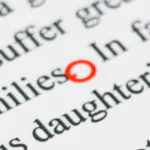
Proofreading Tips: Parentheses and Square Brackets in Chicago Style
Parentheses and square brackets are punctuation marks used to set off certain bits of information from the main text in a document. They’re not too tricky, but different style guides can have slightly different rules for their usage. And, as a proofreader, you’ll need to check your client’s writing against these rules. This post, then, will cover the guidelines for parentheses and square brackets in Chicago style.
Parentheses
First, how and when are parentheses used in Chicago style?
Parentheses are used to offset material from the surrounding text. For instance:
They talked at length about their favorite sports (football, tennis, cricket, etc.) before dinner.
This was due to the delay in freezing (see chapter 3).
Paronomasie (more commonly known as wordplay) is common.
However, parentheses can also be used for enclosing numbers in run-in lists. For example:
The items found included (1) bread, (2) eggs, and (3) milk.
Or for glosses of unfamiliar or non-English words in the main text:
They had what Germans call a Backpfeifengesicht (a very slappable face).
Parentheses also have a grouping role in some mathematical equations.
Finally, parentheses can be used to enclose in-text citations or information in footnotes. However, you will need to know which version of Chicago referencing your client is using to know exactly how and where to use parentheses in references.
Square Brackets
The main use of square brackets in Chicago style is to offset material within parentheses. This might occur when, for example, a source is cited inside parentheses:
This is addressed more thoroughly elsewhere (see, for example, Gronley’s [1999] analysis).
You will also see square brackets when an author has amended a quotation. This is most common when amending a quotation to fit with the surrounding text, to note missing or illegible words, or to add explanatory or clarificatory text. For instance:
They [the Grachovas] left town last Wednesday.
Sometimes, an author may also include a term in its original language in a translated quotation. This can be important when the original word is more specific than the translation. In the following, for instance, kummerspeck is translated as “weight,” but the original term implies weight gained from emotional eating, so the author has included it in square brackets so the reader can see that they have decided to translate it in a particular way:
The source claims they had “gained weight [kummerspeck].”
Parentheses and Square Brackets in Relation to Surrounding Text
There are a couple of things to be aware of when it comes to formatting parentheses and square brackets in relation to the surrounding text:
- Parentheses and square brackets should be in the same font (roman or italic) as the surrounding text, not that of the enclosed material.
- In print, typesetters may use an extra thin space if an italic letter overlaps a non-slanting parenthesis or square bracket. For electronic works, the author shouldn’t add any extra spaces.
Parentheses and Square Brackets in Relation to Other Punctuation
The Chicago Manual of Style has some general punctuation conventions. And if your client’s writing features parentheses and square brackets, you’ll also need to be aware of how they work alongside other punctuation marks:
- Opening parentheses should only come after a comma or semicolon in an enumeration or list.
- Closing parentheses should never come directly after a comma, semicolon, or colon.
- Periods should only precede closing parentheses when the entire sentence is enclosed in parentheses.
- Question marks, exclamation marks, and closing quotation marks should only precede a closing parenthesis when they belong with the phrase inside the parentheses.
For square brackets, most of the same principles apply. However, because square brackets are used more in editorial insertions, the use of other punctuation around them will depend on the source text used.
Become a Proofreader
We’ve covered everything you need to know about parentheses and square brackets in Chicago style in this post. But if you want to learn about other style guides and punctuation rules, our Becoming A Proofreader course covers everything you need to know to start work as a freelance proofreader. Sign up today or check out our free trial.



Leave a Comment
Your email address will not be published.